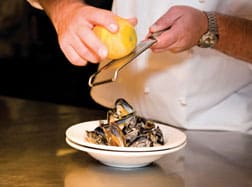At Aida Bistro, the best seat in the house has a view of the chef
STORY BY Martha Thomas PHOTOGRAPHY BY Meredith Tankersley
 When Aida Bistro moved to its new location – a stone’s throw from its home of more than eight years, in a Columbia office park – owner Joe Barbera and Chef Sean Riggs knew one thing for sure. “We wanted a chef’s table,” says Barbera. “We’d been to them and really liked the idea.”
When Aida Bistro moved to its new location – a stone’s throw from its home of more than eight years, in a Columbia office park – owner Joe Barbera and Chef Sean Riggs knew one thing for sure. “We wanted a chef’s table,” says Barbera. “We’d been to them and really liked the idea.”
The concept was part of the design of the new kitchen, says Riggs. Indeed, the bar-height polished stone table sits at the corner of a prep counter in the kitchen, with a view of the oversized stoves, the dessert station and the stainless steel surface where plates are readied to be sent out to the dining room.
 Inside the brightly lit kitchen, servers come and go while the cooking staff ladle sauce on a dish of pasta, slide a flatbread in the oven or torch a crème brulée. If you happen to have a seat at the chef’s table, you’re there to witness it all. On the best days, says Riggs, the dining room is busy, and the kitchen staff is in full swing. “We do what we do, and whoever is sitting at the chef’s table gets to see that.”
Inside the brightly lit kitchen, servers come and go while the cooking staff ladle sauce on a dish of pasta, slide a flatbread in the oven or torch a crème brulée. If you happen to have a seat at the chef’s table, you’re there to witness it all. On the best days, says Riggs, the dining room is busy, and the kitchen staff is in full swing. “We do what we do, and whoever is sitting at the chef’s table gets to see that.”
A table in the kitchen was once reserved for staff on break, while a dining room table close to the kitchen door was considered the equivalent of exile. But as diners have sought to get close to chefs – to examine and learn from kitchen procedures – chef’s tables have become increasingly popular. Restaurants’ renditions of chefs tables range from a spot just outside the kitchen entrance, where a series of specially prepared courses are personally presented by the chef, to stools lined up along a prep counter, so diners can watch every step of the process.
 Someone’s in the kitchen: Dining at the Aida chef’s
Someone’s in the kitchen: Dining at the Aida chef’s
table can mean a mini cooking lesson.Since it opened Aida has developed a loyal customer base, a clientele hungry not only for the Italian specialties on the menu, but for a unique dining experience, says Barbera. The chef’s table takes that experience up a notch. The owner and chef decided to limit the seating to four, to ensure that the experience would be intimate for guests without becoming too distracting for the kitchen staff. And since the restaurant began offering the option around Valentine’s Day 2011, business has been a pretty steady one or two chef’s tables per week, says Riggs.
The introduction of the chef’s table coincides perfectly with another innovation at Aida Bistro. The restaurant offers 30 wines dispensed from taps behind the bar. The flexibility of all these different wines – available in small portions without the need to open an entire bottle – means more options for wine and food pairings. The nine small courses (yes, nine) plus dessert, we had on a recent evening, were paired with wine – sometimes smaller pours befitting of the diminutive plates, other times a larger draught of wine to bridge a couple of courses. Chef’s table diners can add the option of wine pairings to their prix fixe meal or order drinks from the bar.
We had the opportunity of dining in the Aida kitchen on a Thursday evening during the winter. The restaurant wasn’t very busy that night, so we had a chance to chat with Riggs as he prepared – and served – our meal.
We started our feast with a plate of cheese, served with apples, house-made mustard and veal bone marrow – a rich treat we could scoop with a spoon, complemented by a festive glass of sparkling rosé. Starting with a cheese plate, says Riggs, means he and guests can settle in, introduce each other and talk about the upcoming meal without worrying about a fussy dish getting cold. “It’s a good grazing course,” he says.
When Riggs knows he’s got a chef’s table on the books, he plans courses both from the regular menu and from his imagination. Ingredients that may be part of other dishes may be reconfigured for a tasting meal, or he might purchase something unique. Because so many of Aida’s regular customers find their way into the kitchen, Riggs likes to tailor certain courses to their personal favorites.
Aida expected a kitchen group of four on the night following our visit, so Riggs had ordered a special he normally wouldn’t prepare for only two diners: tuna tartare. The Asian-influenced dish of raw chopped fish came with wasabi and cucumber, and the wine accompaniment was a smooth and subtly sweet Albarino.
Each course was creative and highlighted one of the restaurant’s specialties, be it pasta, seafood or mozzarella. The oysters “two ways” was a small plate with an oyster flash-fried in blue cornmeal along with a slithery bivalve on its half shell. We loved the fat shrimp, served solo on an oversized mouthful of spaghetti twisted around a fork.
A highlight of the meal was the hand-pulled mozzarella. Riggs hauled a hunk of fresh cheese from a pot of hot water he’d placed on the worktable in front of us, and proceeded to stretch and knead it until it reached just the right consistency – firm but not rubbery, slightly chewy, not mealy. He twisted off small pieces and arranged them on plates, with a dollop of tomato sauce and slices of crostini, and once the rest of the cheese had cooled, wrapped it in plastic for us to take home. “It’s a nice souvenir for the evening,” he says. “Better than a signed menu.” We couldn’t agree more.
When I made our reservation, Joe Barbera asked if we had any menu preferences, and I told him that while my partner Dan, is a pescaterian, I am a devoted omnivore and didn’t want to inhibit the chef’s creativity. Our meal was mostly fish – in great variety. Courses six and seven, respectively, were day boat scallops, pan seared and served with balsamic bagna cauda (a “warm bath” of garlic, anchovies and balsamic vinegar), and walnut-crusted mahi with pumpkin polenta and maple-glazed Brussels sprouts. The next two courses moved away from the fish, with chestnut soup spooned over a scoop of duck confit for course number eight. Finally, I was treated to a succulent dish of braised short rib, happily a small portion, but nevertheless a nice way to crown a varied and delicious repast.
Even when the restaurant is busy, Riggs takes time to interact with chef’s table diners, to answer questions about preparations and ingredients or simply to chat. “Usually, all I have to say is one ‘aboot’,” he says, with his Canadian inflection of the word about, “and we end up talking about Canada.” The chef, born in Ontario, came to the U.S for business school, but ended up at culinary school in Annapolis. Riggs has been at Aida for seven years, five as executive chef. It’s fun to watch him at work. And that’s just the way he likes it. “When the restaurant is busy, we just do our own thing” in the kitchen, he says. “The guests at the chef’s table just sit back and watch the show.”




